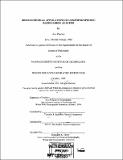Biogeochemical applications of compound-specific radiocarbon analysis
Author(s)
Pearson, Ann, 1971-
DownloadFull printable version (20.34Mb)
Other Contributors
Joint Program in Oceanography.
Advisor
Timothy I. Eglinton and Margaret K. Tivey.
Terms of use
Metadata
Show full item recordAbstract
Compound-specific carbon isotopic (613C and A14C) data are reported for lipid biomarkers isolated from Santa Monica Basin (SMB) and Santa Barbara Basin (SBB) surface sediments. These organic compounds represent phytoplanktonic, zooplanktonic, bacterial, archaeal, terrestrial, and fossil carbon sources. The lipids include long-chain n-alkanes, fatty acids (as FAMEs), n-alcohols, C30 mid-chain ketols and diols, sterols, hopanols, and ether-linked C40-biphytanes of Archaea. The data show that the carbon source for most of the biomarkers is marine euphotic zone primary production or subsequent heterotrophic consumption of this biomass. Two lipid classes represent exceptions to this finding. A14C values for the n-alkanes are consistent with mixed fossil and contemporary terrestrial plant sources. The archaeal isoprenoid data reflect chemoautotrophic growth below the euphotic zone. The biomarker class most clearly representing marine phytoplanktonic production is the sterols. It is suggested, therefore, that the sterols could serve as paleoceanographic tracers for surface-water DIC. The isotopic data are used to construct two algebraic models. The first calculates the contributions of fossil and modern vascular plant carbon to SMB n-alkanes. This model indicates that the A14C of the modern component is +235%o (post-bomb) or 0%o (pre-bomb). The second model uses these values to determine the origin of sedimentary TOC. The results are comparable to estimates based on other approaches and suggest that -60% of SMB TOC is of marine origin, modern terrestrial and fossil sources contribute -10% each, and the remaining -20% is of unknown origin.
Description
Thesis (Ph.D.)--Joint Program in Oceanography (Massachusetts Institute of Technology, Dept. of Earth, Atmospheric and Planetary Sciences; and the Woods Hole Oceanographic Institution), February 2000. Includes bibliographical references.
Date issued
2000Department
Joint Program in Oceanography; Woods Hole Oceanographic Institution; Massachusetts Institute of Technology. Department of Ocean EngineeringPublisher
Massachusetts Institute of Technology
Keywords
Joint Program in Oceanography., Woods Hole Oceanographic Institution.